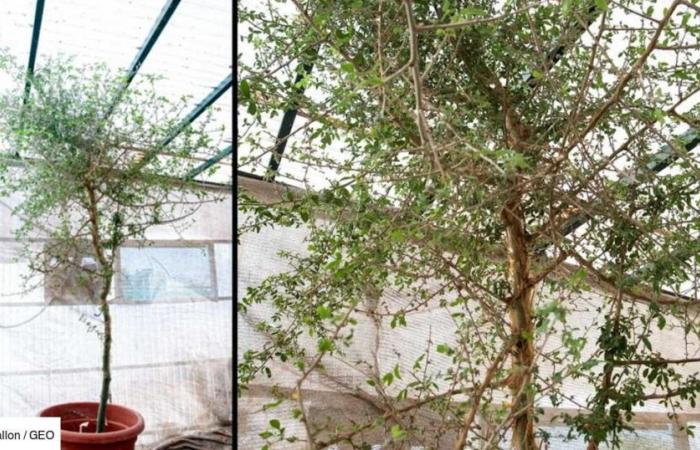
So young, and yet so old. Under the greenhouse that saw it grow, the specimen that is the object of all the attention is only 14 years old – which, for a tree, corresponds to early childhood. But the seed from which it came, discovered in a cave in the Judean Desert (Levant region) in the late 1980s and planted in 2010, is said to have formed… between the years 993 and 1202 AD!
Nicknamed “Sheba” (Saba, in Latin), this living mystery now stands at three metres tall, meaning scientists can “finally describe its full characteristics”explain our colleagues at Live Science.
The results of these descriptions, but also those of DNA, chemical and isotopic analyses carried out by a team of Israeli, French (University of Strasbourg / CNRS) and American researchers, were the subject of a recent study published on September 10, 2024 in the journal Communications Biology.
A cousin of myrrh and frankincense
According to this study, the species belongs to the genus Commiphorawhich itself is part of the myrrh and frankincense family (Burseraceae) and which currently includes about 200 species, found mainly in continental Africa, Madagascar and the Arabian Peninsula.
However, because the tree has not yet flowered and has therefore not produced the reproductive material that scientists need to carry out further analysis, it is currently impossible to say with certainty which species “Sheba” belongs to. In any case, it should prove to be closely related to Commiphora angolensis, C. neglecta And C. tenuipetiolatathree species from southern Africa.
It is therefore likely that the seed came from a population of trees that has now disappeared from the region corresponding to present-day Israel, Palestine and Jordan, the authors believe. Could it be that it is mentioned in the sacred texts?
Balm of Judea or biblical “tsori”?
The team first saw in “Sheba” a “candidate” ideal for the “Balm of Judea” or “Balm of Gilead”, a fragrant resin mentioned several times in the Bible. Indeed, doubts remain as to whether another species, Commiphora gileadensiswhich is the origin of this fragrance prized in Antiquity.
However, the lack of aromatic compounds (molecules that are the source of many perfumes) in the tissues of “Sheba” eventually led the authors to refute this idea. Their analyses revealed a plethora of medicinal properties in this specimen that led them to a second hypothesis.
Researchers believe the tree may actually be the source of the biblical “tsori” – another resin, this time associated with healing in Genesis, the Book of Jeremiah and Ezekiel, and whose name can be translated as “balm”.
Anti-inflammatory, anti-cancer, antioxidant…
The location of the seed would be consistent with the established link between this substance and the historical region of Gilead, located east of the Jordan River, between the Yarmuk River and the northern Dead Sea. In addition, chemical analysis of the leaves and resin of “Sheba” reveals a wealth of “pentacyclic triterpenoids”, compounds with anti-inflammatory and anticancer properties.
According to the study, the leaves and stems are also rich in squalene, a natural oily substance with antioxidant and skin-smoothing properties, Live Science notes. And more work seems needed to identify another potentially cancer-fighting compound in the tree’s tissues.
“We believe that these results support our second hypothesis, namely that ‘Sheba’ (…) could represent a [lignée] extinct (or at least disappeared) formerly native to this region, whose ‘tsori’ resin mentioned in biblical texts was precious, associated with healing but not described as perfumed”the study suggests. To be continued…





